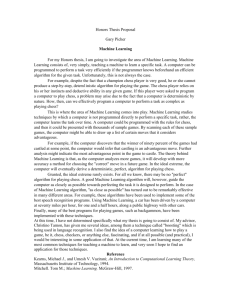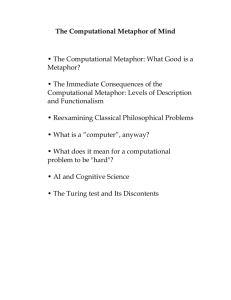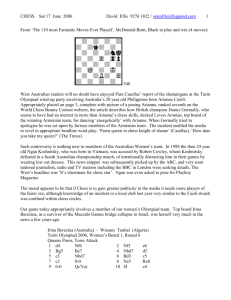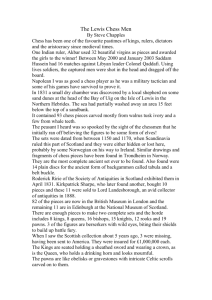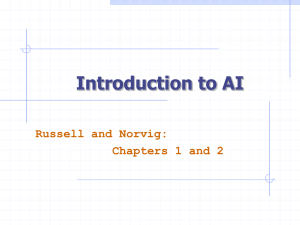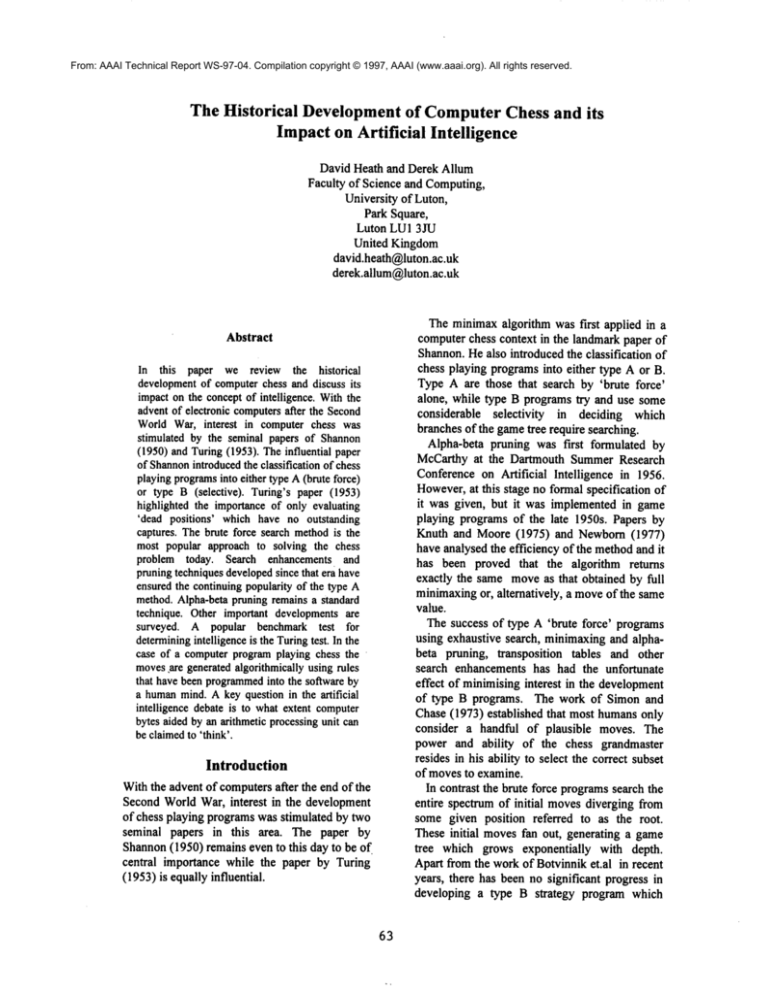
From: AAAI Technical Report WS-97-04. Compilation copyright © 1997, AAAI (www.aaai.org). All rights reserved.
The Historical Development of ComputerChess and its
Impact on Artificial Intelligence
David Heath and Derek Allum
Faculty of Science and Computing,
University of Luton,
Park Square,
Luton LU1 3JU
United Kingdom
david.heath@luton.ac.uk
derek.allum@luton.ac.uk
The minimaxalgorithm was first applied in a
computerchess context in the landmarkpaper of
Shannon.He also introduced the classification of
chess playing programsinto either type A or B.
Type A are those that search by ’brute force’
alone, while type B programs try and use some
considerable selectivity in deciding which
branches of the gametree require searching.
Alpha-beta pruning was first formulated by
McCarthy at the Dartmouth SummerResearch
Conference on Artificial Intelligence in 1956.
However,at this stage no formal specification of
it was given, but it was implemented in game
playing programs of the late 1950s. Papers by
Knuth and Moore (1975) and Newborn (1977)
have analysed the efficiency of the methodand it
has been proved that the algorithm returns
exactly the same moveas that obtained by full
minimaxingor, alternatively, a moveof the same
value.
The success of type A ’brute force’ programs
using exhaustive search, minimaxingand alphabeta pruning, transposition tables and other
search enhancements has had the unfortunate
effect of minimising interest in the development
of type B programs. The work of Simon and
Chase (1973) established that most humansonly
consider a handful of plausible moves. The
power and ability of the chess grandmaster
resides in his ability to select the correct subset
of movesto examine.
In contrast the brute force programssearch the
entire spectrum of initial movesdiverging from
some given position referred to as the root.
These initial movesfan out, generating a game
tree which grows exponentially with depth.
Apart from the work of Botvinnik et.al in recent
years, there has been no significant progress in
developing a type B strategy program which
Abstract
In this paper we review the historical
developmentof computerchess and discuss its
impacton the conceptof intelligence. Withthe
adventof electronic computersafter the Second
World War, interest in computer chess was
stimulated by the seminal papers of Shannon
(1950) and Turing(1953). Theinfluential paper
of Shannon
introducedthe classification of chess
playingprogramsinto either type A(brute force)
or type B (selective). Turing’s paper (1953)
highlighted the importanceof only evaluating
’dead positions’ which have no outstanding
captures. Thebrute force search methodis the
most popular approach to solving the chess
problem today. Search enhancements and
pruningtechniquesdevelopedsince that era have
ensuredthe continuingpopularity of the type A
method.Alpha-betapruning remainsa standard
technique. Other important developmentsare
surveyed. A popular benchmark test for
determining
intelligenceis the Turingtest. In the
case of a computerprogramplaying chess the
movesare generatedalgorithmicallyusing rules
that havebeenprogrammed
into the software by
a humanmind. Akey questionin the artificial
intelligence debate is to what extent computer
bytes aided by an arithmetic processingunit can
be claimedto ’think’.
Introduction
Withthe advent of computersafter the end of the
Second World War, interest in the development
of chess playing programswas stimulated by two
seminal papers in this area. The paper by
Shannon(1950) remains even to this day to be
central importance while the paper by Turing
(I 953)is equallyinfluential.
63
wouldreduce the initial span of the search tree.
The successful development of algorithms that
introduced selectivity into the search engine, so
that the program followed similar lines of
thought to those of a chess grandmaster, would
considerably reduce the amount of searching
required.
Turing’s paper (1953) highlighted
the
importance of only evaluating ’dead positions’
which have no outstanding captures. It is from
this paper the term ’Turing dead’ is taken. Most
chess programs search to a quiescent position
(Turing dead) and then evaluate the position as
function of the material balance and other
features. This evaluation function encapsulates
chess-specific knowledgetypically relating to
pawnstructures and king safety.
History
The historical evolution of computer chess
programming techniques and knowledge can be
conveniently discussed in three broad eras. Each
era is characterised by its own particular
developments, some of which can be directly
linked to increased processor power, the
availability of new hardware devices and others
to algorithmic advances.
The boundary between each era is not always
precise as it is sometimes not easy to draw a
clear dividing line across a time continuum.Any
such process is artificial. However,these broad
historical eras are (Donskoy and Schaeffer
1990):
(i) 1st era (1950 - c1975)
(ii)
2ndera(c1975-c1985)
(iii)
3rd era (c1985 onwards)
The first pioneering era as stated above runs
from 1950-c1975.Here there is a definite point
at which this history commences,markedby the
publication of Shannon’spaper and the advent of
electronic computers. These computers, although
originally
regarded as revolutionary
and
powerful, had but a fraction of the computing
power of the current
generation
of
microprocessors. Indeed hardware limitations
characterise the first era of computer chess
development, requiring highly selective
techniques in order to produce moves in an
acceptable time. The earliest programs were,
therefore, Shannontype B.
64
The first significant chess playing program
was by Bernstein (1957) and ran on an IBM704
computer, capable of performing approximately
42,000 operations per second. This was not a
’brute force’ programas it only selected the best
seven movesfor consideration using heuristics
based on chess lore. Compared to the
sophisticated brute force programs of today
which generate the full span of moves at the
root, this is a very limited range of moves.
The Bernstein program was built around the
strategy of working to a plan. As it was
incapable of doing a full width search due to
time considerations, it selected its quota of seven
movesfor deeper analysis by seeking the answer
to eight questions.
Once the moves were
selected, they were analysed to a search depth of
4 ply. The potential replies by the opponentwere
also selected on the basis of seeking answers to
the sameset of questions.
Bernstein’s
program played at a very
elementary level and the first programto attain
any recognisable standard of play was that of
Greenblatt (1968). For a number of years this
remained the most proficient chess program and
played at an Elo strength of approximately1500.
It had carefully chosen quiesence rules to aid
tactical strength and wasalso the first programto
use transposition tables to reduce the search
space. However, the Greenblatt program also
used an initial selection process to minimizethe
size of the game-tree as the computinghardware
of that era was incapable of achieving the
computingspeeds of today. Again this program,
because of its selectivity at the root node, falls
into the first era.
The first programto achieve full width search
and make ’brute force’ appear a viable
possibility was Chess 4.5. This program was
developed for entry into the ACM1973
Computer Chess contest by Slate and Atkin,
using the experience they had gained in
programming earlier selective search chess
programs. The techniques used by Slate and
Atkin (1977) are still in use today although they
have been refined and improved over the years.
These standard techniques initiated what maybe
classed as the second technology era giving rise
to programstypically searching to a fixed depth
as fast as possible and then resolving the horizon
problemby extending checks at the cutoff depth
and considering captures only in a quiescence
search.
The second era of computer chess also saw
more emphasis placed on the developmentof
dedicated chess hardware. Typical of such
developments was Ken Thompson’s chess
machine Belle which won the ACMNorth
American Computer Chess Championship in
1978. The special purpose hardwareincreased
the speed of Belle enabling it to analyse 30
million positions in 3 minutes and search
exhaustively to 8 or 9 ply in middlegame
positions. It also hadan extensiveopeningbook.
Belle won the 3rd World Computer Chess
Championshipin 1983, achieving a rating of
over 2200in 1980and wasthe first programto
receive a Masterrating. It was for Belle that
Thompson
devised his first end gamedatabase,
solving the KQKR
problemand hence partially
removingthe perceivedweaknessat that time of
computersin endgame
positions.
In 1975 Hyatt commencedwork on Blitz
whichwas then entered in the ACM
1976 North
American Computer Chess Championship.
Initially Blitz wasselective andrelied ona local
evaluation function to discard moves.However,
the availability
of the world’s fastest
supercomputer,the Cray, enabled the program
appropriately renamedCrayBlitz, to use brute
force and in 1981it wassearchingapproximately
3000 nodes per second and consistently
achievingsix ply searches.This rate of analysis
was improvedby the use of assemblylanguage
and the availability of the Cray XMP
computer
with multiprocessing
facilities, allowing20,00030,000nodesto be searchedper secondin 1983.
Thethird stage, aptly namedalgorithmic by
Donskoyand Schaeffer (1990), extends onwards
fromthe mid1980sto the current time. This has
seen someconsiderableactivity in the refinement
of the basic tree searchingalgorithmsused(see
later). It has also seen the emergence
of personal
computerson a scale originally unenvisaged.
Thewidespreadpractice of incorporating vast
openingbooksand morecd-romsfor end games.
This current phase has been most fruitful and
seen a considerable increase in the playing
strength of chessprogramsto the point wherethe
top commercialsoftware programsare generally
recognisedas being superior to humansat speed
chessandin sharptactical positions. Understrict
tournament conditions the most highly rated
player of all time Kasparovhas nowlost a game,
but not the match,against DeepBlue.
65
Move Ordering Techniques
Theprevioussection has outlined the historical
developmentof computerchess. The transition
to ShannonB type programsto ShannonA is not
solely attributable to increasedcomputing
power.
It also partly arose out of
increased
understandingof the alpha-beta algorithmwhich
was subjected to deep analysis by Knuthand
Moore(1975). Other techniques for increasing
the efficiency of the search and pruning
mechanismsalso becamemore prominentat the
beginningof the secondera.
Producinga cutoff as soonas possiblewith the
alpha-beta algorithm considerably reduces the
size of the search tree. Consequently, move
ordering is an important aspect of achieving
maximum
speed since, if weknowthe best move
in a certain situation producingit early rather
than late, will havebeneficialresults. Theworst
case is wherethe movesare examinedin such an
order as to produceno cutoffs, generating the
maximum
numberof nodes to be analysed. This
is the maximaltree whichgrowsexponentially
with depth, d, so that the numberof nodes
examinedassuminga uniformbranchingfactor,
b, is givenby bd. Thebest situation is wherethe
moves are all well-ordered and provide
immediatecutoffs, producingthe minimaltree
which,althoughit also growsexponentiallywith
depth, is very muchreduced in size by the
cutoffs. In betweenthese two extremeswehave
gametrees generated by chess programswhich,
initially are unordered,but becomeprogressivley
moreorderedas the depthof searchincreases.
Algorithmic developments and various
heuristics are movingthe programscloser to the
minimaltree. This progressive improvement
in
reachingcloser and closer to the minimaltree is
borne out by Belle, whichit is estimated came
within a factor of 2.2 of the minimaltree,
Phoenixwithin a factor of 1.4 and Zugzwang
withinan impressivefactor of 1.2 (Plaat 1996).
Iterative deepening is a useful device for
allowing movesto be re-ordered prior to the
depth being increased as well as providing a
methodfor limiting search depth in responseto
time constraints. Originallyintroducedin 1969,
it has becomestandard practice in brute force
programs.
Thekiller heuristic is another moveordering
techniqueusing informationfromthe alpha-beta
pruning algorithmto facilitate it. Whenever
a
certain movecauses a cutoff in response to
another move,then it is likely that it is able to
refute other movesin a similar position. Such a
moveis a ’killer move’and can be stored in a
killer table so that it can be tried first in order to
cause another cutoff. Captures and mate threats
provide the commonest form of such ’killer
moves’. In this context the null move can
provide a list of the most powerfulmovesfor the
opponent and assist in the move ordering
process.
The killer heuristic was described in detail by
Slate and Atkin (1977) although it had been used
in earlier chess programs. However,the benefits
of this technique are controversial with Hyatt
claiming an 80% reduction while Gillolgly
observed no such significant reduction in size
(Plaat 1996).
A generalisation of the killer heuristic is the
history heuristic introduced by Schaeffer (1989).
This extends the ideas of the killer heuristic to
include all the interior moveswhichare ordered
on the basis of their cutoff history.
Tree Searching
variation is searched with a full width alpha-beta
search, while others are searched with a minimal
windowwhere [3 = (x + 1.
With perfect moveordering, all movesoutside
those estimated to be part of the principal
variation will be worse than those estimated to
be on it. This is proved when the minimal
windowsearch fails low. Should this search fail
high, a re-search has to be done with full alphabeta width.
A refinement on PVS is NegaScout. This is
very similar to PVS and incorporates the
observation that the last two plies of a tree in a
fail-soft search alwaysreturn an exact value.
There have been a number of further
derivations of the so-called zero windowalphabeta algorithm, whichuse a zero (actually unity)
windowat all nodes, unlike PVSwhich uses zero
windowonly awayfrom the principal variation.
Oneof these is described by Plaat et al. (1996a)
and has been given the name MTD(f).It relies
on a large memoryto hold a transposition table
containing records of previous visits to nodes.
Werecall that in fact gameslike chess really take
the form of graphs rather than trees, so that a
particular board position might be visited from
manydifferent paths. The memoryshould be as
large as feasible, since it serves to hold as many
as possible of the results of visiting nodes.
Since the memoryenhanced test algorithms
operate with zero window,they, of necessity,
need to do manyre-searches. It is the use of
memory to help speed up the production of
results that makesthese algorithms competitive
in speed. Although Plaat et al. (1996a) claim
their version is faster in practice than PVS,R.
Hyatt, as he wrote in the rec.games.
chess.computer Usenet newsgroup, in April
1997, still uses PVS for his Crafty chess
program. The following pseudo-code from Plaat
et al. (1996a)illustrates their MTD(f)
version.
Algorithms
Chess programs have used till now almost
exclusively one of a variety of related algorithms
to search for the best move. Constant
improvementsin the search algorithm have been
sought to reduce the numberof nodes visited,
and thus speed up the program.
We now briefly
describe
a number of
variations upon the alpha-beta algorithm. These
depend on having some knowledge, albeit
imperfect, of what is the most likely principal
variation, the series of moves downthe tree
consisting of the best play.
The usual call to alpha-beta at the root node
has an infinite window. In aspiration search
someinitial estimate of a likely value is made
together with a window,or band of values this
likely value could lie in. Clearly the success of
this algorithmdependson the initial estimates. If
a value is returned which lies outside the
aspiration search windowthen a re-search needs
to be done with full alpha-beta width. There is
thus a trade-off to be made between a greater
degree of pruning using the limited windowand
the amountof re-search which has to be done.
Principal variation search (PVS)is a variation
of alpha-beta search where the search at a
particular level is ordered according to some
evaluation function. The node which is found to
be the most likely memberof the principal
function MTDF(node-type, f,d)-+
g := f;
upperbound := +o0;
lowerbound :=-oo;
repeat
if g = lowerbound then
[3 :=g+ I;
else
[3 := g;
g:=ABWM(root,[3-1,[3,
depth);
if g < [3 then
upperbound := g;
66
the processes of humanreasoning. They argued
that if it was possible for computersto solve the
chess problem, it must be possible for computers
to tackle other difficult problems relating to
planning and applications to the economy.This
preoccupation with intelligence formed the core
of Turing’s work, commencingwith the creation
of Turing machines and then the formulation of
the Turing test which still remains of central
importancein the AI debate today.
Turing himself worked in the period 1940-45
at Bletchley Park as an Enigmacode-breaker. An
indifferent
chess player himself, he was,
however, in the constant companyof the best
British chess players of that era, thus creating the
environmentand ideas for the final phase of his
work. The luring test states that if the responses
of a computerare indistinguishable from those of
a humanit possesses intelligence. Consequently,
it can be argued that a computer playing chess
possesses intelligence as, in many cases, its
movesare identical to those of chess experts.
This is the strong AI viewpoint.
It was precisely to repudiate these claims of
intelligence that Searle (1980) put forward his
famous Chinese Roomargument against strong
AI. Chess programs produce their moves
algorithmically. Suppose another humanbeing
having no prior knowledge of chess per se,
performs the same algorithms, does he also
understand the game?The weak AI viewpoint is
that computers lack any such intelligence or
understanding. This viewpoint is supported by
Penrose (1995) who cites an example of
position in which Deep Thought blundered
because of its lack of understanding of a
particular position, despite being capable of
deceiving us into thinking that it really has some
chess intelligence.
else
lowerbound := g;
until lowerbound >-- upperbound;
return g;
The algorithm works by calling ABWM
a
number of times with a zero window search.
Each call returns a boundon the minimaxvalue.
These bounds are stored in upperbound and
lowerbound,forming an interval around the true
minimax value for that search depth. Whenthe
upper and lower bounds collide, the minimax
value is found.
ABWM(AlphaBetaWithMemory)
is
conventional alpha-beta algorithm which has
extra lines to store and retrieve information into
and out of a transposition table.
Interest
has also been shown in the B*
algorithm as well as those involving conspiracy
numbers. These are more complex than
algorithms involving alpha-beta searches, and
seem to get closer to the Shannon B kind of
algorithm where some expert knowledge of the
gameis programmedin to guide the machine.
Impact on AI and Philosophy
In the pioneering era, both computerchess and
AI were emergingdisciplines. At that early stage
computerchess was regarded as a testbed for AI
search and problem solving techniques. The
early chess programswere primitive but are now
much more sophisticated
and have achieved
spectacular results. However,as recognised by
Donskoyand Schaeffer (1990), the dominantion
of AI by computer chess has nowchanged and it
is currently viewedas a small part of AI with its
methods, identified primarily as brute force,
regarded within the AI communityas simplistic.
However,the impact of computer chess on AI
can be gauged by the number of methods
developed within the chess environmentthat are
domainindependent and applicable elsewhere. It
is, for instance, undeniable that computerchess
has made significant contributions to search
techniques whichfind applications in other areas
such as theorem proving and problem solving in
general. It has also emphasised the development
of special hardwareto solve the chess problem, a
viewpoint which is echoed in other areas of AI
(Horacek 1993).
The computerscientists and AI enthusiasts that
initiated the pioneering era of computer chess
were partly motivated by a desire to investigate
Conclusion
The strength of the top chess playing programsis
continually increasing. In this paper we have
reviewed the main techniques that have enabled
programmers to achieve such a spectacular
increase in playing strength commencingwith
the earliest
exploratory programs to the
sophisticated software of today. During this
period, we have seen significant increases in
processing power which, despite the prevalent
von Neumannarchitecture of today, is still
increasing in power. Consequently, we foresee
67
the possibility of further increases in playing
strength.
Future work will probably refme the
traditional Shannon A type algorithms even
more. For example, new avenues of research still
exist on application-independent techniques of
exploiting the fact that computerchess trees are
really graphs (Plaat 1996b). However,there is
limit on the extent to which this can proceed.
The consideration of ShannonB type algorithms
is an area requiring further investigation and
development.
References
Botvinnik, M.; Cherevik, D.; Vladimirov, V.,
and Vygodsky, V. 1994. Solving Shannon’s
Problem: Ways and Means, Advances in
ComputerChess 7, van der Herik H. J, Hersberg
I.S, and Uiterwijk, J.W.H.M.(eds) Maastricht,
University of Limburg.
Donskoy, M.V and Schaeffer,
J. 1990.
Perspectives
on Falling from Grace, in
Computers, Chess and Cognition, Marsland, T
and Schaeffer, J. (eds) NewYork, Springer
Verlag.
Horacek, H. 1993. Computer Chess, its
Impact on Artificial Intelligence, ICCAJournal
16(1):31-36.
Knuth, D.E, and Moore, R.W. 1975. An
pruning. Artificial
analysis of alpha-beta
Intelligence 6(4):293-326.
Newborn, M.M.1977. An analysis of alphabeta pruning. Artificial Intelligence 6:137- 153.
68
Penrose, g. 1995. in Shadows of the Mind,
London, Vintage.
Plaat, A.1996. Research Re:Search and Research. Ph.D.diss., Dept. of ComputerScience,
ErasmusUniversity.
Plaat, A., Schaeffer, J., Pijls, W., and de Bruin,
A. 1996a. Best-first
fixed-depth minmax
algorithms, Artificial Intelligence 87:255-293.
Plaat, A., Schaeffer, J., Pijls, W., and de
Bruin, A. 1996b. Exploiting GraphProperties of
GameTrees, Proceedings of the 13th National
Conferenceon Artificial Intelligence, Portland,
Oregon.
Searle, J.R.
1980. Minds, brains amd
programs, in The behavioural and brain
sciences, Vol 3. Cambridge, Cambridge
University Press.
Schaeffer, J.1989. The history heuristic and
alpha-beta search enhancements in practice,
IEEE Transactions on Pattern Analysis and
MachineIntelligence, 11(1):1203-1212.
Shannon, C.E. 1950. Programming a
Computer for Playing Chess. Philosophical
Magazine41(7): 256-275.
Simmon,H.A and Chase, W.G. 1973. Skill in
Chess. AmericanScientist, 6 l, 482-488.
Slate, D and Atkin, L.1977. Chess 4.5:The
North Western University Chess Program, in
Chess Skill in Manand Machine, P.Frey(ed.),
82-118. NewYork, Springer Verlag.
Turing, A. M. 1953. Digital computers
applied to games, in Faster than Thought,
Bowden,B.V.(ed). London, Pitman.


